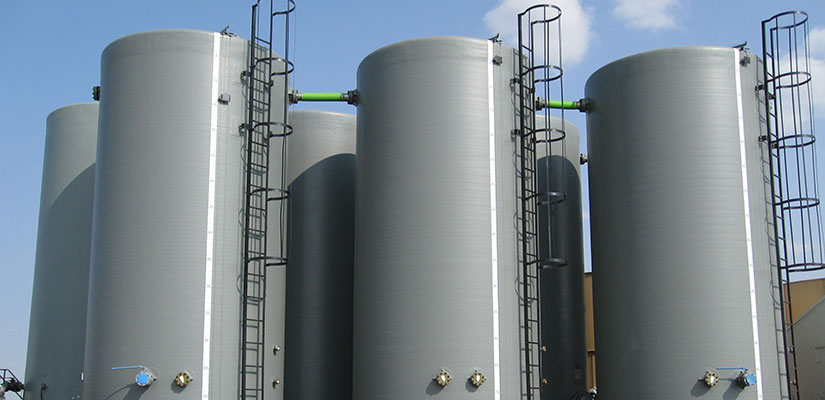
Large, above-ground composites storage tanks are being used in a variety of chemical and water storage applications.
Composites are big news in the world today, and those that ignore them do so at their own peril. We've put together five areas where composites are proving most important.
- Upgrading waste and waste water treatment plants
Municipalities feel the pressure from Environmental Protection Agency (EPA) regulations to upgrade waste pipes and waste water treatment plants. These items come under the heading of upgrading existing infrastructure in the US. EPA regulations require that municipalities switch from chlorine gas to liquid sodium hypochlorite as the preferred treatment chemical. Hypochlorite is an acid and corrosive so builders are turning to corrosive-resistent composite materials to upgrade existing infrastructure. Three manufacturers supporting New Jersey's upgrade of its waste water treatment plants in the aftermath of Hurricane Sandy have five new FRP odor control systems under construction. Chemical storage tanks up to 10 feet in diameter will store 12.5% sodium hypochlorite and 50% sodium hydroxide for the odor control process. Manufacturing for the upgraded equipment includes filament winding, chop spray up and hand layup. - Water Conservation Projects
Water conservation is critical in many parts of the US. Manufacturers have under construction FRP tanks that can hold up to 66,000 gallons and greater for both residential and commercial uses. Especially popular are rainwater harvesting systems, especially in the Southwestern and Western states. Rainwater can hydrate gardens and provide fire protection. It is possible to have potable drinking water from rainwater as well. The University of Texas, for example, has a rainwater/stormwater project utilizing a fiberglass collection tank. The University of Binghamton, Binghamton, New York has had four FRP rainwater collection tanks since 2013. The tanks hold 200,000 gallons of water making it the largest rainwater harvesting endeavor in NY. As changes in weather bring long-lasting drought to certain areas of the country, being able to produce or harvest fresh water becomes more a part of society's ideas on sustainability living. - Seawater Desalination
Parts of the country that lie near seawater (like California, Florida, and Texas) are seeing an increased interest in seawater desalination. The tanks for this process are different from the ones used for rainwater collection. The process uses reverse osmosis to make drinkable water for homes in dry areas. Desalination will have long-term possibilities as countries increase their investment in the process. Infrastructure made of FRP pipes and tanks will desalinate greater amounts of seawater. So far, the largest reverse osmosis desalination project under construction is in Carlsbad, California. The designers and manufacturers anticipate that the tanks will process 50 million gallons of seawater per day. The FRP tank is filament wound with E-glass and vinyl esters as well as isophthalic resins to resist corrosion. The pipe carries a NSF certification too since it will produce drinking water at the end of the process. - Oil & Gas Markets
Companies developing shale deposits are creating opportunities for desalination in Montana, Pennsylvania, Texas, and Ohio. The deeper the well the more the water will need cleaned. New ways to handle waste streams often use fiberglass in their systems. FRP tanks and piping appear in the drilling environment and in the refineries. The diameters of the pipes and the tanks are getting bigger in response to the water recycling issue. - Bio-Resin Market (Green Composites)
Sustainable building practices, such as the Leadership in Engineering and Environmental Design (LEED) certification of the United States Building Council, are driving the innovation in bio-based composite materials. The search for low emission, energy-efficient, and low toxicity materials bodes well for composites. Their innate characteristics of endurance, low weight, low thermal conductivity, and flexibility in design fit the needs of the green builders.
To talk more about composites, or anything else, click the button below. We look forward to exchanging ideas with you.





